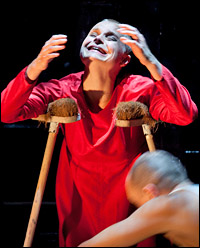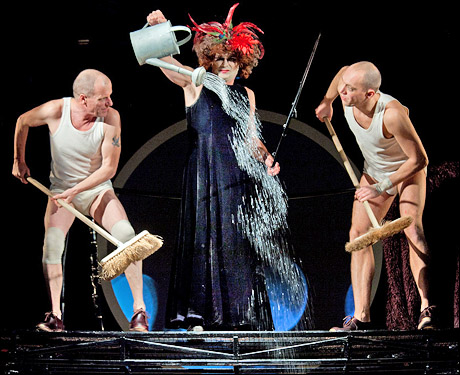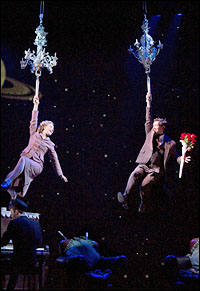
*
Emma Rice, the visionary British director whose adaptation of Noel Coward's Brief Encounter stretches our expectation of theatrical form with the bold use of songs, contemporary references, stark imagery, dance, flying, puppets, projections and more, currently has two productions playing in New York City. For Britain's Kneehigh Theatre Company, Rice put her own spin on Hans Christian Andersen's dark 19th-century tale of punishment, "The Red Shoes," back in 2002. Rice's The Red Shoes, revived in honor of Kneehigh's 30th anniversary, is finally getting its American premiere at St. Ann's Warehouse in Brooklyn, now to Dec. 12. Brief Encounter played a limited run at St. Ann's in December 2009, and, by fall 2010, the show was reconstituted for Broadway's Studio 54, where it continues to Jan. 2, 2011. A few weeks before The Red Shoes arrived in Brooklyn, we phoned Rice (currently prepping the musical The Umbrellas of Cherbourg for London's West End) and spoke to her about the legend of the girl who was punished for wanting vivid footwear.
I love that you honor the domestic drama of Brief Encounter, that there is a core story there, but what you do with it is so cracklingly alive. So theatrical.
Emma Rice: Oh, thank you so much. That's wonderful.
The Red Shoes predates Brief Encounter…
ER: It does! It's [from] ten years [ago]. It's a decade earlier. I think it's interesting because I think the themes [of the two shows] are very, very similar, but the world is so different. It's a very bold piece, very physical, quite austere in its own way, so in some ways, there's worlds between Brief Encounter and Red Shoes, and in other ways, it's really about the same thing. It's about personal freedom and choice and passion.
I'm at a disadvantage because I haven't seen the production yet. Can you give me a sense of it? Is Hans Christian Andersen the jumping-off point?
ER: It is, yes. It's certainly the folk story rather than the [famous 1948] film. It's definitely using the Hans Christian Andersen story, but I also went back further and found some earlier oral tellings of the story, and then I've changed it. I've made it my own. I got very cross on behalf of my heroine, because in all the versions of this story, she's punished! In many, including Hans Christian Andersen, she dies, and in others, she's put into a life of servitude, and I thought, "There's no way that I'm going to do that to my heroine." So this is absolutely a re-telling. I read somewhere that you really didn't know The Red Shoes. You knew the title. Is that right?
ER: Yes. [Laughs.] It's completely true! I sort of look back on it with horror, really, at the lack of preparation. I just announced that I was to do The Red Shoes and then thought, "What have I done?" And it was only then that I went and — well, first of all, watched the film, and I thought, "Well, this is a disaster," because the film is very operatic. It's got quite a strange narrative, there's lots of orchestral numbers, and I thought, "Well, this is nothing to do with me and is sort of unstageable," particularly as Kneehigh was a very small company at the time. So it was then I went on and read the folk tale and was very profoundly moved, but also shaken, really, at how relevant the story was. So I really felt that it came and found me. I feel quite spiritual about it.
What is retained in terms of the Hans Christian Andersen story that some people know? That Andersen story is all about vanity, isn't it?
ER: Oh, God, no. [Laughs.] I think it's all about identity. I think that [the story of] "The Red Shoes" [has] been interpreted as [being about] vanity and desire for something that's maybe not appropriate, but I personally believe that "The Red Shoes" [is] absolutely about who she is, and it's really taken away from her. In one of the earliest tellings, which is what I was very inspired by, the first thing that happens is her mother dies and she's orphaned, and she makes herself a pair of shoes out of red leaves and berries, and they're very beautiful and they're very natural. And it's when she [is] adopted by the old lady that…these shoes [are taken] from her, and really, it's from that point that she becomes obsessed with replacing those red shoes. So they become a metaphor for trying to replace what's been taken away from you, whether it's the mother that's died or indeed these natural, homemade shoes that she's created. So I think it's nothing to do with vanity. I think it might be interpreted as vanity, but it's about, really, the quest for who you are.
Does your story involve shoes of leaves and berries?
ER: The earliest version I found has these shoes made of leaves and berries. My shoes are indeed found, but they're not leaves and berries, so I've, again, sort of made it my own.
| |
 |
|
| Patrycja Kujawska in The Red Shoes | ||
| photo by by Pavel Antonov |
ER: Yes, what happened was I started to [work on] what I wanted the story to be — literally what happens, who we meet, and certainly what I feel a measure of the story is. And then I worked with a poet called Anna Maria Murphy and commissioned a collection of poems inspired by those characters and those events — not a script. When you see the show, that gives it quite a fairy-tale-like quality. There's no naturalism here; nobody's at a kitchen sink in this show. But it's very much a storytelling that's based on the harsh meanings of the story. The way the poetry works — I think it gives it a great gravitas to have the poetry there, but it also gives it a childlike sense of telling a story.
Is it about individualism?
ER: Yes, it is, although when you say that word, I think, "Oh, gosh, is it?" I think it's really about balancing what your own needs as an individual are against the requirements of society and people that you come into contact with, and what I love about the story is there's no easy answers. I'm certainly not saying, "We must all be individuals and do what we like," but neither am I saying, "You must conform to what's expected of you." What I think the story examines is the tension between those two things, and I think certainly, for women and girls, that's huge — absolutely huge — and that's where the links to Brief Encounter come into sharp relief. Just what happens as a woman when you think, "I don't want children" or "I wish I hadn't had children" or "I could be something different." It's a very, very tough choice, and I think that The Red Shoes, as a metaphor, is really all about the cost of those choices, as well, which is, again, why I think the story is so resonant — these choices are not simple ones, not at all, and almost whichever way our girl goes, she has to pay a price for it.
 |
| Mike Shepherd, Giles King and Robert Luckay in The Red Shoes |
| photo by Pavel Antonov |
| |
 |
|
| Hannah Yelland and Tristan Sturrock in Brief Encounter | ||
| photo by Joan Marcus |
ER: It's a complete mixture. It's original music that's being played live, but it's also interwoven with soundtrack music, so it's a real fusion, which I think, again, really adds to that contemporary fairy-tale quality. It's as if you've broken the mirror of your life, and watching it fall back into fragments in slightly different order.
When you're working on a new piece, is it very improv-rich in the room? Is it "play"?
ER: Absolutely. It's very hard to describe process. I think I have a very strong idea of why we're telling the story and what kind of world I want the story to live in, but then once I've created those very strong boundaries, then there's an awful lot of play, and that's when the actors and the performers and the musicians and the writers bring great wealth into the room, and where you really cash in on the collective imagination rather than the individual one. But it's certainly not free-for-all. I do have very, very clear guidance about what it is we're searching for.
Do you laugh a lot in the room?
ER: All the time. There's nothing better than making a piece of work. Everything's on the edge. I mean, that's why laughter happens all the time. Not only are people very funny, and I have the privilege of working with the most exceptional people, but you're making terrible mistakes, as well. People fall over, people say the wrong thing, people have strong ideas that don't work. Just that level of play is very funny, so we have absolutely the best of times. And because we all trust each other very much and the work is very strong, it's very safe. If you do fall over and do something embarrassing, then that's marvelous. We celebrate that.
Although The Red Shoes is not naturalism, as you say, can you tell me, plot-wise, what her name is and what happens to her in a very general way?
ER: Well, she has no name. She's called The Girl, which is very much a decision, because I feel this actually isn't about an individual. We're all The Girl. And her mother dies, and in her grief, she makes herself a pair of red shoes. And it's really about the fact that, even though she's sad at that point and bereaved, that she is herself. But an old lady comes along and takes her in and takes these shoes off her, scrubs her clean, dresses her and takes her to church. But what happens is, she falls in love with a pair of red shoes, and she can't stop thinking about them. She's told not to wear the shoes in church but she still does, and then she begins to dance and she loves this. And she dances and dances and dances across the hills until she thinks she'd like to stop, and she realizes she can't stop. …And then it goes very macabre and the red shoes swarm her, but she fights them off in my story, so she finds her way back to herself.
There's hope.
ER: Absolutely, there's hope. I've never found another version of "The Red Shoes" in which The Girl, the heroine, has lived and had a future, and that's absolutely what I've given her in this version. (Kenneth Jones is managing editor of Playbill.com. Reach him at [email protected].)
Watch highlights from Brief Encounter on Broadway:










